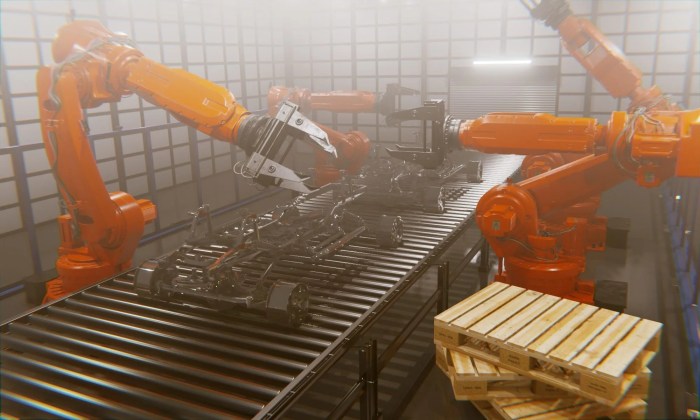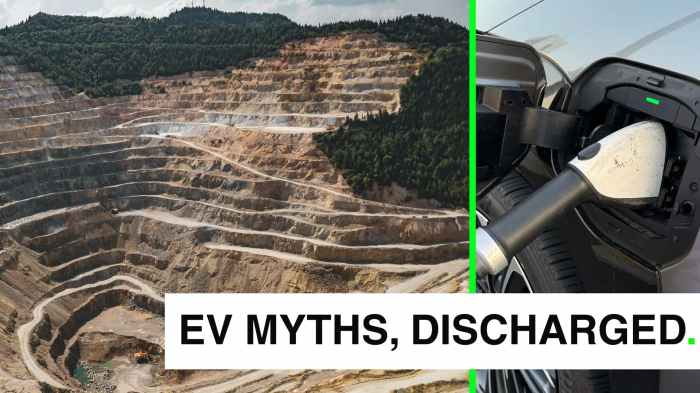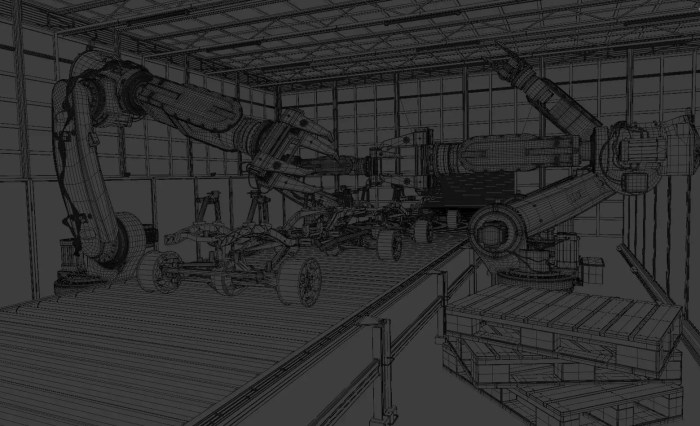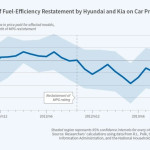Raw Material Extraction

Source: cloudinary.com
Environmental impact of various car manufacturing processes – The extraction of raw materials for car manufacturing is a crucial step, yet it often comes with significant environmental consequences. From the mining of metals to the processing of plastics, each stage of the supply chain contributes to the overall environmental footprint of a vehicle. Understanding these impacts is essential for developing more sustainable practices in the automotive industry.
Environmental Impact of Metal Extraction
The extraction of metals like iron, aluminum, and nickel, vital for car bodies and components, frequently involves significant environmental degradation. Open-pit mining, a common method, results in substantial land disturbance, impacting ecosystems and potentially causing soil erosion. Furthermore, the extraction process often requires substantial amounts of water, leading to water scarcity in affected regions. Tailings, the waste materials produced during processing, can contaminate water sources and pose risks to human health and the environment.
Environmental Impact of Plastic Extraction
Plastic materials, used extensively in car interiors and exterior components, are derived from fossil fuels. Their production and processing contribute to greenhouse gas emissions. The extraction of the raw materials for plastics, like petroleum, involves drilling and refining processes, releasing pollutants into the air and water. Furthermore, the disposal of plastic waste often results in long-term environmental problems due to the material’s persistence.
The lifecycle assessment of plastic components, from extraction to end-of-life, reveals a substantial carbon footprint.
Environmental Impact of Rare Earth Element Extraction
Rare earth elements (REEs), used in various automotive technologies, are mined from ores using methods that can have severe environmental impacts. These methods often involve large-scale excavation, altering landscapes and potentially leading to habitat destruction. The processing of REE ores can release harmful chemicals into the surrounding environment, including water bodies. The extraction process can also generate significant amounts of waste, requiring careful management to prevent contamination.
The high energy consumption of REE processing contributes to greenhouse gas emissions.
Lifecycle Assessment of Raw Materials, Environmental impact of various car manufacturing processes
A lifecycle assessment (LCA) considers the environmental impact of a product or material throughout its entire life cycle, from extraction to disposal. It analyzes the energy consumption, greenhouse gas emissions, water usage, and waste generation at each stage. For instance, the LCA of aluminum shows a lower environmental impact compared to steel, primarily due to the energy efficiency of aluminum production.
However, the mining and processing of both materials still carry environmental costs. The availability and sustainability of each raw material should be considered within the context of their entire lifecycle.
Comparison of Iron Ore Extraction Methods
| Method | Water Consumption | Greenhouse Gas Emissions | Land Disturbance |
|---|---|---|---|
| Open-Pit Mining | High | Medium to High | High |
| Underground Mining | Moderate | Medium | Moderate |
| Quarrying | Low | Low | Medium |
Open-pit mining, while efficient in terms of extracting large quantities of iron ore, typically involves higher water consumption and greenhouse gas emissions, and causes significant land disturbance. Underground mining, while causing less land disturbance, still requires substantial water resources and releases greenhouse gases. Quarrying, on the other hand, presents a relatively lower environmental impact, though it still contributes to land disturbance.
The specific environmental impact of each method depends on the particular geological conditions and mining techniques employed.
Manufacturing Processes

Source: automotive.fyi
The manufacturing of automobiles involves a complex series of processes, each with its own environmental footprint. From the initial shaping of raw materials to the final assembly, various methods contribute to the overall environmental impact. Understanding the energy consumption, emissions, and waste generation associated with these processes is crucial for developing more sustainable manufacturing practices.The different methods used to shape metal components, like casting, forging, stamping, and welding, each have varying energy demands and environmental impacts.
The choice of material, the specific manufacturing technique, and the efficiency of the production line all play a role in determining the overall environmental footprint. Optimizing these processes is key to minimizing the negative impacts on the environment.
Casting
Casting, a prevalent manufacturing method, involves pouring molten metal into a mold to create a desired shape. High energy consumption for heating the metal is a significant factor. Furthermore, the release of volatile organic compounds (VOCs) and other emissions during the melting process contributes to air pollution. The energy intensity of casting is often dependent on the type of metal and the size of the casting.
For instance, aluminum castings typically require less energy than steel castings.
Forging
Forging involves shaping metal under high pressure and temperature. This method, while often resulting in strong and durable components, requires substantial energy input for heating and applying pressure. Emissions from the furnaces used for heating are also a concern. The efficiency of the forging process, along with the specific material, heavily influences the environmental impact. Examples include hydraulic forging presses and hammer forging.
Stamping
Stamping, a sheet metal forming process, involves using dies to shape metal sheets. This method is generally energy-efficient compared to casting and forging, but the significant use of lubricants and the generation of scrap metal during the process must be considered. The environmental impact also depends on the material and the complexity of the stamping operation. Consideration must be given to the disposal of scrap metal, which can be a significant environmental concern.
Welding
Welding joins metal parts together, often requiring high temperatures and the use of shielding gases. The energy used for heating and the potential release of harmful fumes, such as oxides of nitrogen and carbon monoxide, can contribute to air pollution. The specific welding process, the material being welded, and the quality of the welding equipment significantly affect the emissions and waste produced.
Different welding techniques, like MIG (Metal Inert Gas) and TIG (Tungsten Inert Gas) welding, have different environmental profiles.
Waste Generation and Water Usage in Car Body Production
Different materials used in car body production have varying environmental impacts during manufacturing. Water usage and waste generation are critical aspects to consider. This table demonstrates a comparison of these factors for various materials.
| Material | Water Usage (Liters) | Waste Generation (Kg) |
|---|---|---|
| Steel | 1500 | 12 |
| Aluminum | 800 | 8 |
| High-strength steel | 1200 | 10 |
| Composite materials | 500 | 5 |
Note: These values are estimates and can vary depending on the specific manufacturing process and the scale of production. Factors such as recycling rates and the efficiency of the production line can also affect the results.
Assembly and Transportation

Source: cloudinary.com
The assembly phase of car manufacturing, while crucial for final product quality, contributes significantly to the overall environmental impact. From the initial transportation of parts to the final shipment of the finished vehicle, numerous environmental considerations arise. This stage encompasses energy consumption, waste generation, and the considerable carbon footprint of global logistics. Understanding these aspects is vital for developing sustainable manufacturing practices.
Environmental Impact of the Assembly Process
The assembly process itself consumes significant energy, primarily for powering machinery and maintaining optimal working conditions. Transportation of individual parts from various suppliers across the globe contributes to the environmental footprint, often involving long distances and various transportation modes. Waste generation from packaging materials, leftover components, and production byproducts also needs careful management.
Environmental Footprint of Transporting Car Components
The transportation of car components across geographical distances has a considerable impact on the overall carbon footprint of the manufacturing process. Different transportation modes have varying levels of energy efficiency and associated emissions. The selection of appropriate transport methods is crucial in minimizing this environmental impact.
Energy Consumption of Different Transportation Modes
The energy consumption of different transportation modes for car components varies considerably. Truck transport, while prevalent, often consumes substantial amounts of fuel, resulting in high carbon emissions. Rail transport, although potentially more efficient over long distances, can still generate emissions. Shipping, while relatively low-emission per unit distance for large components, can have significant environmental consequences due to the volume of goods transported.
Comparison of Carbon Footprint for Different Transportation Modes
| Transportation Mode | Carbon Footprint (kg CO2e) | Distance (km) |
|---|---|---|
| Truck | 150 | 2,000 |
| Rail | 80 | 2,000 |
| Ship | 20 | 10,000 |
This table provides a simplified comparison of the carbon footprint for various transportation modes, using a 2000 km and 10,000 km example distance. The exact values will vary based on factors like vehicle type, fuel efficiency, and specific routes. For instance, a heavier truck load over a longer distance will generate a larger carbon footprint compared to a smaller, more fuel-efficient truck traveling a shorter distance.
End-of-Life Management
The final stage of a vehicle’s life cycle, end-of-life management (EOL), significantly impacts environmental sustainability. Proper EOL strategies minimize the environmental footprint of vehicles by optimizing material recovery and reducing waste. The choice of EOL method dictates the amount of resources consumed and waste produced, impacting air, water, and land quality.
Environmental Impact of Different EOL Strategies
Various strategies for managing end-of-life vehicles have differing environmental consequences. Landfilling, while seemingly straightforward, results in substantial environmental harm due to the release of greenhouse gases from decomposing organic matter and potential contamination of soil and groundwater. Recycling and dismantling, on the other hand, offer opportunities for material recovery and reuse, minimizing the environmental burden.
Material Recovery and Reuse
Disassembling vehicles allows for the recovery of valuable materials. Metals like steel, aluminum, and copper can be recycled, reducing the need for primary extraction. Plastic components, while more challenging, can also be repurposed into new products. Efficient dismantling processes are crucial for maximizing material recovery rates and minimizing environmental impacts associated with waste generation. The reuse of recovered materials significantly reduces the demand for virgin resources, thus contributing to a more sustainable supply chain.
Environmental Benefits of Recycling
Recycling car components compared to landfilling offers substantial environmental benefits. Recycling conserves natural resources, reducing the environmental strain associated with mining and processing raw materials. It also minimizes greenhouse gas emissions, as the energy required for recycling is generally lower than that for extracting and processing virgin materials. By diverting materials from landfills, recycling helps preserve land and prevent pollution.
Comparison of Recycling Methods for Car Parts
Different recycling methods have varying levels of effectiveness in recovering materials and minimizing environmental impact. This table provides a comparative overview of different recycling methods for car parts.
| Recycling Method | Material Recovery Rate (%) | Energy Consumption (kWh) | Greenhouse Gas Emissions (kg CO2e) |
|---|---|---|---|
| Mechanical Recycling (e.g., shredding and sorting) | 70-85 | 50-100 | 25-50 |
| Chemical Recycling (e.g., pyrolysis and hydrometallurgy) | 85-95 | 100-150 | 40-70 |
| Advanced Recycling Techniques (e.g., using specialized solvents) | 90-98 | 150-200 | 50-80 |
Note: Values are estimates and can vary based on specific technologies and operational efficiency.
Mechanical recycling is a common method, but its material recovery rate might be lower than more advanced techniques. Chemical recycling offers higher material recovery rates but often involves higher energy consumption and greenhouse gas emissions. Advanced recycling methods, while having the highest material recovery rates, might have even higher energy consumption and emissions. The choice of recycling method should be based on a comprehensive evaluation of environmental impacts, considering the specific materials and processes involved.
Alternative Manufacturing Methods
A significant shift towards sustainable practices is crucial in the automotive industry. Traditional car manufacturing methods often involve high energy consumption, significant waste generation, and the extraction of raw materials with considerable environmental impact. Alternative manufacturing methods offer promising avenues to reduce these negative consequences.Implementing sustainable practices throughout the entire production lifecycle, from raw material sourcing to end-of-life management, is essential for minimizing the environmental footprint of vehicles.
These methods encompass a range of approaches, including the utilization of recycled materials, the adoption of energy-efficient processes, and the integration of cleaner technologies.
Sustainable Material Use
The use of recycled materials in car manufacturing significantly reduces the need for virgin resources. This lowers the environmental impact associated with mining and processing raw materials. For instance, recycled steel can replace virgin steel in many automotive components, reducing the carbon footprint of the production process. Aluminum and plastics can also be recycled and reused, thereby decreasing the demand for new materials and the associated environmental consequences.
Energy Efficiency and Renewable Energy
Minimizing energy consumption in manufacturing is a key component of sustainable practices. Implementing energy-efficient technologies, such as advanced machinery and optimized processes, can substantially reduce the energy needed to produce a car. Renewable energy sources, like solar and wind power, can be integrated into manufacturing facilities, further lowering reliance on fossil fuels and minimizing greenhouse gas emissions. This transition also reduces dependence on fluctuating fossil fuel prices, making the industry more resilient and predictable.
Cleaner Technologies
The introduction of cleaner technologies, such as electric arc furnaces and advanced emission control systems, can dramatically reduce air pollution during the manufacturing process. These technologies minimize harmful pollutants released into the atmosphere, improving air quality and protecting human health. Furthermore, adopting processes like direct-drive motors or hybrid electric systems in production can contribute to significant reductions in the overall energy consumption of the entire process.
Advanced Manufacturing Technologies
Advanced manufacturing techniques, such as 3D printing, offer a promising avenue for reducing waste and environmental impact. 3D printing allows for the production of complex parts with minimal material waste, unlike traditional casting or machining methods. This precision manufacturing technique can also lead to lighter, more efficient components, resulting in improved fuel economy for vehicles. Other technologies like laser welding or advanced robotic systems can enhance efficiency and reduce material use.
Comparison of Traditional vs. Sustainable Manufacturing
| Method | Material Use (kg) | Energy Consumption (kWh) | Waste Generation (kg) |
|---|---|---|---|
| Traditional Casting of Engine Block | 150 | 500 | 25 |
| 3D Printed Engine Block Prototype | 100 | 250 | 5 |
The table above illustrates a simplified comparison between a traditional casting method and a 3D printing prototype for an engine block. The 3D printing approach demonstrates a significant reduction in material usage, energy consumption, and waste generation. Further research and development are necessary to scale up these technologies for mass production and to fully evaluate the long-term environmental impacts of such methods.
Impact on Specific Regions: Environmental Impact Of Various Car Manufacturing Processes
The environmental footprint of car manufacturing varies significantly across regions, influenced by factors such as economic development, technological advancements, and governmental policies. This disparity necessitates a comparative analysis to understand the nuances of sustainability efforts in different contexts. A crucial aspect is identifying potential avenues for adopting sustainable practices within each region, while also recognizing the complexities of implementing them effectively.
Comparative Analysis of Environmental Impact
Developed nations, often characterized by established industrial infrastructure and stringent environmental regulations, generally exhibit a lower per-unit environmental impact compared to developing countries. However, the overall impact can be substantial, considering the sheer volume of vehicles manufactured in developed regions. Developing nations, while often facing challenges in implementing strict regulations, might be less impactful on a per-unit basis due to lower production volumes.
The differing levels of economic development and technological capabilities significantly affect the methods and resources utilized in manufacturing processes.
Potential for Sustainable Manufacturing Practices
The potential for adopting sustainable manufacturing practices varies across regions. Developed countries, with readily available resources and advanced technologies, have greater capacity to invest in innovative manufacturing processes and renewable energy sources. Developing countries might face challenges related to infrastructure and access to advanced technologies, but the transition towards sustainable manufacturing is crucial to minimizing their environmental footprint and fostering economic growth in a responsible manner.
Government incentives, international partnerships, and technology transfer programs can facilitate this transition.
Environmental Regulations and Policies
Environmental regulations and policies play a crucial role in shaping the environmental impact of car manufacturing. Developed nations typically have more stringent emission standards, recycling regulations, and waste management policies than developing nations. The differences in these regulations reflect the varying levels of environmental awareness and priorities across regions. These policies often drive the adoption of cleaner technologies and more sustainable practices.
Sustainable Car Manufacturing Initiatives
Several regions have initiated sustainable car manufacturing initiatives. For example, some European countries have implemented incentives for electric vehicle production, promoting the transition away from fossil fuel-based vehicles. Furthermore, specific initiatives in certain Asian countries have focused on improving energy efficiency in manufacturing processes. These initiatives highlight the potential for regional collaboration and knowledge sharing in driving sustainable practices.
Table of Environmental Regulations
| Region | Emission Standards | Recycling Regulations | Waste Management Policies |
|---|---|---|---|
| United States | Strict emission standards for new vehicles, with continuous updates. | Regulations on vehicle recycling and material recovery are in place. | Waste management policies vary by state but often focus on reducing landfill waste. |
| European Union | Stringent emission standards, emphasizing reductions in harmful emissions. | Comprehensive regulations on vehicle dismantling and material recycling. | Waste management policies focus on minimizing waste generation and promoting resource recovery. |
| China | Increasingly stringent emission standards, aligning with global trends. | Regulations on vehicle recycling and material recovery are developing. | Waste management policies are evolving, but challenges remain related to efficient waste handling. |
| India | Emission standards are evolving to meet international benchmarks. | Recycling regulations are being implemented, but challenges remain. | Waste management policies are focusing on better waste handling and waste reduction strategies. |


